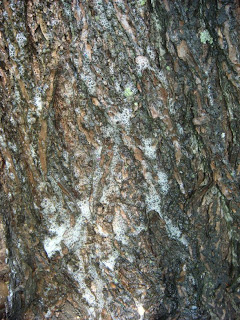White Pine Tea In Winter
After skimming the latest Northern Woodlands magazine, I
stumbled across an article about brewing native winter teas, naturally high in vitamins
A and C. This was an intriguing idea, and I decided to take a stab at brewing
my own tea from white pine. That was an activity I’d heard of before in passing,
but hadn't considered in depth, and I decided to give it a try.
Eastern White Pine (Pinus
strobus) is a well-known and common native of the northeast. Its’ range
stretches from eastern Canada though the northeast U.S. states as far south as Georgia.
White pine grows large and lives a long time, and historically, even played a small
part in the events leading up to the American Revolution. The British Navy needed
sturdy wood for its’ ships to defend their ever-growing empire, but faced a shortage
of trees at home. They discovered that tall white pines in the American
colonies worked very well, and forbade anyone but the crown to cut down pines
of a certain size. This was a deeply unpopular, and led to the Pine Tree Riot in New Hampshire several years before the war began.
White pine is also distinctive
and easy to identify, even for non-tree experts such as myself. Just look for the
distinctive needles in groups of 5. However, because it grows tall and often
has no lower branches within reach, this provides an obvious challenge to
gathering the needles… for tea or for any other reason (unless your name is Stretch
Armstrong). Luckily my mom happens to have a small one planted in her yard. Picking
off some needles was as simple as reaching out my hand. I chose not to think of
this as “cheating” but rather as a natural version of the McDonald’s
drive-thru.
Now comes the tricky part-actually brewing the tea. The
article suggests steeping one to two tablespoons of the chopped needles in a
pint of boiling water for a couple of minutes (also, some sources recommend avoiding if you're pregnant.) My first experiment, following
these directions, resulted in a very weak “tea” that looked nothing like the
tea in the picture. “Pine water” would be more apt but less appetizing. The
taste wasn’t actively unpleasant though, so I tried again. For my second attempt
adjusted the ration, adding more needles and less water, and steeping the mixture
longer. The end result was a concoction that was “pine-y” but still not unpleasant
or overpowering.
My mom watched with a skeptical eye during my experiment.
“Does it taste like turpentine?” she wanted to know.
“No, like a very mild stick of chewing gum. Or maybe like pine.”
Overall, white pine tea is never going to win any “best-tasting”
awards. As the article notes, well-known naturalist and forager Euell Gibbons was
a proponent of the tea, and the strongest praise he could find was “almost enjoyable”
with sugar and lemon. Still, it was a fun experiment to try, and a reminder of
a bygone world before easy access to daily citrus and multi-vitamins.




.jpg)
.jpg)
Comments
Post a Comment
Feel free to let us know what you think.